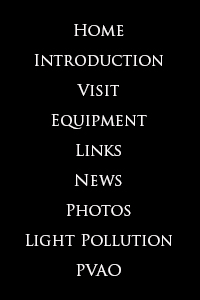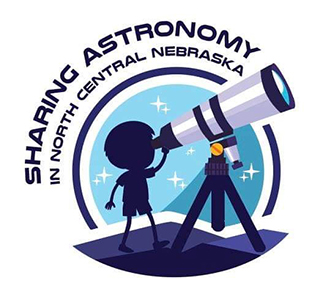
O'Neill Nebraska
Director - Mark Urwiller
Staff: Leon Thompson, Lianna Murphy
Honey Creek Observatory
Light Pollution Page

Merry Christmas!
Play Christmas Jazz!
Night lighting (other than that originally provided by nature) has become a fact of life. It has become necessary in many cases. However, we here at Honey Creek Observatory would like to bring to public awareness that not all lights are necessary and most could be adapted in such a way to provide the same level of security and safety, sometimes better, AT A LOWER COST!
The graphic above is linked to a larger format version which gives you an idea what we are talking about. This photo shows a night time view of the United States from space taken by satellite. Here's a link showing the earth at night - Blue Marble Navigator The point we are trying to make by these links are - everything you see is wasted light! The need for light exists here on terra firma, but not up there! In addition, the wasted scattered light makes enjoyment and study of the night sky more difficult. Over the last few years, many light fixtures have been designed to provide shielding in order to direct the light DOWN where it is needed. If these fixtures are installed, the wattage of the bulbs used can be decreased and still provide the same amount of light and security where it's needed. THAT SAVES MONEY!Recently there is a new option that can be a problem if not implemented in a sensible way! Amateur astronomers have begun to call it The New Light Pollution! LED lighting has offered a new way to light our surroundings at night. It has become competitively priced to install. It uses much less electricity and it lasts much longer than conventional gas bulb sources. Who can blame people for gravitating toward this option. However there are caveats!
One of these drawbacks comes from the belief that "more is better". Since we now have a cheaper alternative to night lighting, let's really light things up! Since LEDs are cheaper, people are putting more of them - more than is needed! In the end , often there is no savings since the total amount of electricity used is the same! Most people are unaware of the concept of "glare", created by improper distribution of the light or too much of it, which can have the opposite of the desired affect - to make things safer. Too much light can decrease contrast as seen by the human eye. Contrast is important in helping us identify objects around us - especially at night. We want contrast to help us navigate and to identify possible hazards or danger. Shielding of LED light fixtures is still important! Too much lighting can cause more problems than it solves!
Here is another problem with LED lighting from the amateur astronomers point of view. This information is shared in the hopes you will find it interesting, and through understanding, perhaps instill a desire to use care in the lighting you install. I taught physics for over 3 decades, so here comes the teacher in me :) I'll try not to get too "deep" into the science while I explain.
The light you see from objects around you comes to your eyes in 3 ways - by reflection, transmission/absorption (light passing through things - like filters, glass etc which absorbs or blocks some of the light) or emission (light given off, like the sun, bulbs etc). Astronomers have an interest in all of these types of light. The colors of objects we see are seldom monochromatic. In simple English, that means they are seldom just one color. We all know that light can be separated into its parts by a prism. Most of us think of a rainbow-like spectrum (range) when we see a prism used with sunlight. May of you may already know that each of the known elements of matter gives off its own unique emission spectrum/fingerprint of light when "excited" The sun contains most all of the known elements and the combination of the light from these elements gives what we call a continuous spectrum which seems to blend uniformly from one color to the next like the top of the graphic below:
Up until the early 1970's most lighting, indoor and outdoor, came from Tungsten filaments - old fashioned light bulbs. These lights gave off continuous spectrums which is not good for astronomy as you will see soon, but the expense of using them in large scale at night was not as much of a problem as lighting has become today.
In the 70's cities began to use lights created from gas bulbs - primarily Mercury Vapor, then later, Sodium lamps. Mercury lamps gave off much more light for less cost than Tungsten. The blue/white color of these lights is actually from just a few colors similar to the "Emission Spectrum" in the middle of the graphic above. Even though they give off a lot of light, astronomers - both professional and amateurs - quickly utilized a way to "filter" out those colors by absorption. Filters can be made to block selective colors of light while allowing other colors to pass through. Notice in the graphic above the colors of light in the middle spectrum are exactly the ones blocked in the bottom spectrum. The rest of the continuous passes through. In astronomy these are called narrow band absorption or narrow band pass filters. When Sodium lights (pinkish/orange) filters came into use, they offered even more light and less electricity usage. They also had non-continuous emission spectrums like the middle graphic above and could be filtered pretty well.
This is not the case with most currently used LED lights! Often LEDs are mostly continuous! They are pretty much impossible to filter at the telescope :( This is the new light pollution! So, what can be done to help keep light pollution from going out of control? The safety issue of glare needs to be promulgated as well as to make sure LEDs are shielded to direct the light down to minimize the light escaping upwards. In the links below, you will also find that LEDs can be manufactured to create spectrums that are still useful for safety and have less adverse affect on the night sky and wildlife.
Yes astronomers, amateur and professional have a special interest in the night sky. If we can also preserve some of the beauty of the night sky so that our children can have the chance see the stars, is that really so bad?
We in the United States spend billions of dollars a year on night lighting! Indeed most new businesses and municipalities are implementing new types of lighting. If you would like to know more of the specifics, please check our links on light pollution from our link page.
We thought maybe it would be helpful to provide examples of various types of light fixtures - good and bad. We will start with the "worst" and generally progress to the "best." Many lights being installed these days are LED, but it is hopes their design can be similar to the "winners" Here goes:The "Bad" Guys
The "old" standard! These fixtures contain either Hg or Na vapor bulbs. What makes them so bad is the extruding globe which dissipates the light up as well as horizontally and down. Once you have driven a car under newer more efficient fixtures, you will really notice the difference! It's much more comfortable on your eyes. As well as wasting energy and money, these guys are a stargazer's nightmare.
Equally as bad, these fixtures are often offered at hardware stores. Again these fixtures contain both Na or Hg bulbs and again the extruding globe is a bane of amateur astronomers!
These fixtures are common around apartment complexes. Their efficiency depends on how and where they are mounted. Too often they are mounted in such a way that light scatters all over the place and they can be pretty obnoxious!
These "beauties" can be very obnoxious - especially if you are unlucky enough to be in front of the fixture! They are used to flood a large areas with light - with little regard to their light trespass upon others!
Another example of a fixture which could be used efficiently, but most often isn't.
Better, But Still Not Great!
This photo was taken at a subdivision in Kearney Nebraska. The bulb within (Na Vapor) are lower in wattage, but the panes of glass allow light to dissipate in all directions except down!
The city of Kearney was installing these in some of their subdivisions. They still allow a great deal of light to emit horizontally and up. The city has since stopped installing them.
These fixtures aren't too bad. The "transparent" enclosure which extrudes underneath still dissipates some light out and up however.
These fixtures are similar to the previous example. The center light is pointed toward a wall to light up a sign - which helps keep it from trespassing over great distances.
The Winners!
Shielding on lights isn't necessarily new. These have been around for quite awhile. Perhaps the only problem with this fixture is that 4 bulbs might constitute overkill!
Kind words for lights are hard to come by from an amateur astronomer, but this one is "appreciated". Notice how the bulb is recessed inside the fixture. Light is directed down!
These "nice" fixtures are installed near a middle school in Kearney. Again the bulb is recessed and the light is directed down! Whoever selected these did their homework! "A" plus.
Another nice light fixture (as lights go anyway).
Remember the nasty fixture we started with up this page. This is the next generation! The state (of Nebraska) highway department is installing these on the highways. I'm also seeing them on the interstate as well. Now if we could just get them to stop installing 6 of them where 1 or none of them was previously necessary!
Light Pollution Links!
Lost in Light - 1 (The observatory location is about level 2)
National Geographic LED/Light Pollution Article
The Lost LED Revolution: Light Pollution is Increasing
Space.com - Light Pollution Article
http://www.astrosociety.org/education/publications/tnl/44/lightpoll.html
http://www.lightpollution.it/dmsp/
International Dark Sky Association
Keep Looking Around!
Mark Urwiller - Web Page Administrator
Send comments to: mark.urwiller@tutanota.com
Mark Urwiller - Web Page AdministratorHome Introduction Visitation Dates Observatory Equipment Links
Observatory News Photos Light Pollution PVAO




